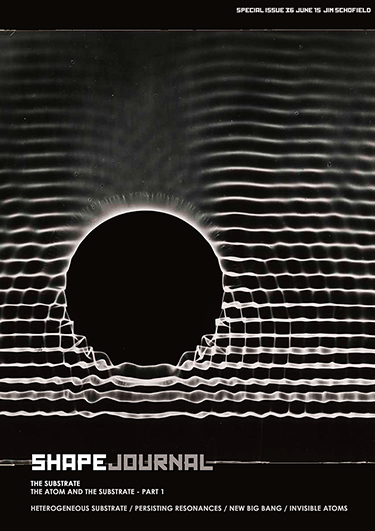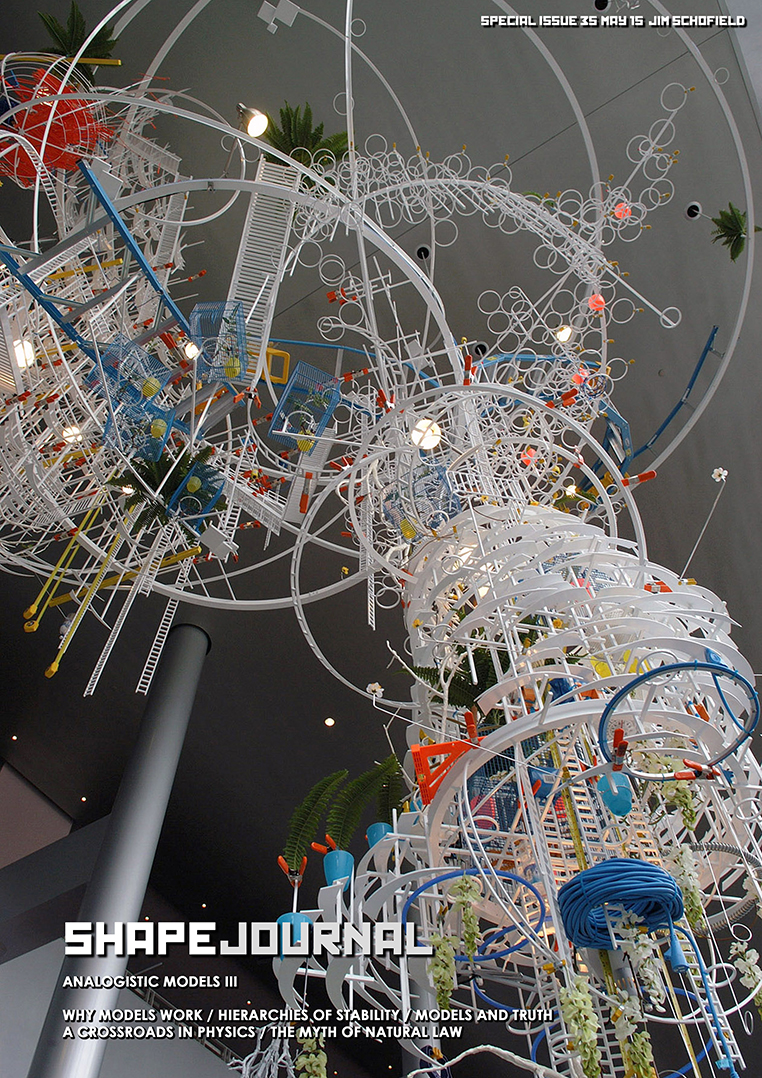I am a physicist, and in my experience, Physics Departments (worth their salt, anyway)
experiments.
So, what happens in Philosophy? Is it like the Art Department in my own (undergraduate) University, which didn’t actually do any Art, but just talked about it? Indeed, I, as a physicist, ended up as the secretary of the Art Society in the University for two years.
Do the members of staff in Philosophy actually practice Philosophy? I ask this question because as a physicist today I simply cannot avoid Philosophy – and, I don’t mean the Philosophy of Science, for such restrictions merely end up being about the History of Mankind in Science, and not about the Understanding of Reality. Surely, Science and Philosophy should be very close bedfellows and work together on this same crucial task?
But, I have also observed that very few of the “doing” physicists have any real idea of their own philosophic stance and underlying assumptions. Yet, after generations of scientists being confirmed materialists (as a matter of course), they, as a body, in the latter part of the 19th century, found that the ground beneath their feet was beginning to shake, and deliver ever more damaging tremors, which threatened the very fabric of their once rock-steady stance. The discovery of the Quantum opened up the biggest ever can of worms. Indeed, great fissures opened up, and something had to be done!
The result, finally consummated in 1927 at the Solvay Conference, was a total abandonment of their prior Mechanical Materialism, but what replaced it was even worse.
In Sub Atomic Physics a totally idealist standpoint, with “materialist” experiments was adopted. Instead of the search for physical causes, the whole approach was re-orientated to merely seek Form in experimental results as sufficient in itself. Causes were either unknown or unknowable, but here in our hands were the useable results. We would not only abandon the next question, namely “Why?”, but we would seek our patterns as themselves being the causes of phenomena. The equations produced were conceived of as the Natural Laws of Reality.
The inference was clear: the found equations were the driving imperatives of Nature – they actually caused observed phenomena.
The purely formal relations (abstracted from Reality most certainly, but there had been simplified and idealised from purposely farmed experimental situations) were turned into being the sole drivers of Reality.
Science had become a branch of Mathematics (and could be researched mainly on a blackboard with chalk). It had been changed into an idealist discipline.
Of course, a fig leaf of “explanation” was vigorously defended, but it certainly was not an attempt at real explanation in terms of physical substances and their properties. It had been removed into the Parallel World of Pure Form alone, which I call
Ideality, and as such was doomed
Of course, there had been a great deal wrong with the prior scientific standpoint. It has for centuries been a dualist compromise between an idealist belief in form, and a materialist search for causal explanations, that somehow remained together as a workable compromise. The equations were so useful, you see: they had to be an objective in any research!
And, along with this illegitimate compromise, the materialist stance was indeed entirely mechanist: it did not address reality's development at all.
The odd genius, such as Darwin, though transcending that stance, did not, and at that stage could not, change the basic standpoint one iota. The basic sciences were about eternal Natural Laws, as encapsulated in formal equations.
You could not THEN challenge that belief!
The vast majority of physicists really did believe that everything in the Universe could be directly explained in terms of a straight-through series of causes, right back to fundamental particles, and also that these were accurately described by the formal equations – the Natural Eternal Laws. You can see the amalgam. It wasn’t easy to demolish by individual gains in isolated areas. It was the generally agreed ground!
Thus, though many linking gaps were evident, they would ultimately be closed, resulting in everything being derived ultimately from the Primary Science that was Physics. And, increasingly within that subject the nitty gritty would then have to be the Study of Fundamental Particles.
Of course, such a stance did not represent the real situation. Indeed, it was miles away from a comprehensive position, but it had been productive at all levels for centuries, and would not be renounced with the occurrence of as yet unexplained anomalies.
Until undeniably demolished, most scientists would stick to Reductionism – the concept that eternal Natural Laws at the bottommost layer of Reality generated absolutely everything else above it – all the way to Life, Consciousness and Society. And in such a context, the various different subjects be they Chemistry, Biology and even Psychology were then only forced sub divisions of a single structure, as would be proved as the missing links were found one by one.
But, of course, that assumption is incorrect!
The divisions into different sciences are not down to mere human categorisation. They are, in fact, reflective of wholly different Levels of Reality, which when they first happened resulted in new worlds with their own relationships, that did not exist prior to that Event.
NOTE: The inability of scientists to discover the Origin of Life proves this conclusively: it isn’t a mere complication of existing laws from a lower Level, but the product of a seismic Revolution.
And, the reason that one can be so adamant about this is that the prevailing stance ignores Development almost entirely, and simply believes it is merely
complication.
Indeed, this criticism is proved by the predominance of the Second Law of Thermodynamics in the views of present day Physicists. For such a Meta law is ONLY about dissolution, and says absolutely nothing about what created the evident structures in an indisputable prior Development. Puny efforts have been made to ally the Second Law with Randomness and Chance, in which that crucial progress in the history of Reality is put down to the roles of these random contributions, but the evident ineffectiveness of such efforts prove that they are mere constructs and reflect nothing of the real Development that has occurred at all!
The problem is, and always was, the shortness of the life spans of individual human beings. No individual could actually observe big developments in reality, and indeed, for millennia, Humanity has considered reality as a fixed thing – an achievement and then a maintenance of a natural stability in all things.
Now, stability, as commonly observed, appeared to be the normal state of Reality, and all change, if there was any at all, was tiny and incremental – occasionally passing some formal quantitative threshold, and thereafter slipping things over into a more conducive and maintainable alternative stability. It was an understandable mistake, but incorrect due to lack of evidence.
The first cracks appeared, centuries ago, in the studies of geologists, who revealed a changing world clearly recorded in the rocks beneath our feet.
But, this development was incredibly long winded – even thousands of years were insufficient to reveal changes, and significant transformative changes were much rarer – usually only apparent over millions of years. And, as the science developed, what it revealed not only included vast changes in the material forms of continents and even the oceans, but also revealed an indisputable evolution of Life itself, AND even the actual time of Life’s Origin on earth.
Yet this subject, Geology, was regarded as merely a “secondary discipline”: its conclusions were majorly distorted by the fact that Geology was a limited discipline, where investigative experiments were impossible, so clearly, the testable and superior discipline of Physics, which could explain things from bottom to top, was still unchallenged as the product of everything there is.
And sadly, even Geology was mute when it came to the clearly evident
step-changes in the record of the rocks.
For such a record, very slowly built up over tens and even hundreds of millions of years, could only clearly deliver established stable levels gradually laid down over colossal periods of time, and the crucial dramatic changes would be located in time, but totally absent as an investigatable record. The essential interludes of major and often qualitative changes were simply unrecorded: all that could be clearly seen would be an impenetrable step-change.
These crucial interludes were invariably of relatively short duration. Indeed, the first indications that such transforming interludes actually occurred were found in the recorded histories and the archaeological revelations of earlier Human Societies. For there, without any doubt, such transforming interludes definitely occurred.
Even in the found remains of earlier human beings, there were clear examples of indisputable evidence of what was then described as the Neolithic Revolution. And, this occurred at a time when the only tools available were knapped fragments of flint, plus a few shaped softer materials such as wood and horn.
Yet in this remarkable interlude, Mankind invented animal husbandry, farming, pottery, weaving and many other new techniques. It was no, slow, incremental set of changes, but just such a relatively short-length Revolution.
Also, from the opposite end of Mankind’s studies, in Social History, came the concepts of Stability and Revolution – an oscillation between long periods of slow, incremental quantitative changes, and short interludes of major, qualitatively transforming changes.
Could this be the natural pattern of all developments at all levels?
Slowly, evidence began to accumulate that this was indeed the case... But, did it change the stance of our physicists? No! They actually admitted that switches occurred in the development of Reality, but also insisted that all of these would ultimately be totally explicable in the usual mechanical materialist ways. No change was necessary in their philosophic stance.
Clearly, following this blinkering, a crisis was unavoidably looming, and it would be a biggy! Indeed, there was a Revolution in the offing. Then finally, that time arrived - the avalanche of contradictions multiplied all the time, and a transcending of the causes (long overdue) became imperative. These head-down scientists were extremely unlikely to allow any generalist, head-up conceptions (by uninformed dreamers) to deflect them from their “holy” path.
The intervention just had to come from without!
It had happened in 19th century politics with the intervention of Karl Marx (a philosopher) into areas such as Social History and Economics, but the necessary intervention in Science was never carried through. Yet, Marx was initially only an academic philosopher – a follower of the idealist giant Hegel, yet his intervention transformed politics.
The question therefore posed at the outset of this paper can now be restated:- “Do academic philosophers
DO philosophy?”
What is their position on the Copenhagen Interpretation of Quantum Theory, and the consequent switch among scientists to Reality itself, being determined by Formal Relations, as embodied in Equations?
Something MUST be going on, which simply must be in the remit of
practising philosophers. For in my developmental studies, contributions by the philosopher Salmon enabled me to see the role of the Principle of Plurality in science. Yet, no moves are then made by today’s philosophers to address this flawed principle, as Hegel would most certainly have done 200 years ago!
The question has to be, “Why?”
Now, if, as seems to be the case, what is studied (and explained?) is merely the History of Philosophy, cannot the trajectory towards Truth be discerned in that, as it was in History by the philosopher Marx?













.jpg)
